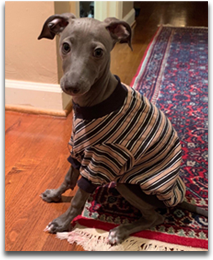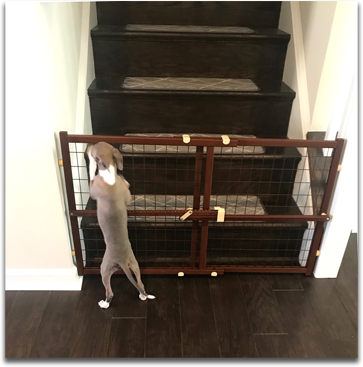
Training
 Italian Greyhounds are often of the mindset of “what’s in this for me?” Therefore, whether you are potty, crate, or trick training, keep it sweet and simple. They are people pleasers and want to make you happy. However, their attention span is short. Small intervals of training repeated a few times a day will achieve your desired results. Again, lots of praise and rewards such as treats will keep them focused and ready to perform to their best ability. I recommend starting obedience training as soon as you get home. They are ready! Google is a wealth of information of the vast variety of commands that can be taught. Again, Italian Greyhounds are very intelligent and learn quickly.
Italian Greyhounds are often of the mindset of “what’s in this for me?” Therefore, whether you are potty, crate, or trick training, keep it sweet and simple. They are people pleasers and want to make you happy. However, their attention span is short. Small intervals of training repeated a few times a day will achieve your desired results. Again, lots of praise and rewards such as treats will keep them focused and ready to perform to their best ability. I recommend starting obedience training as soon as you get home. They are ready! Google is a wealth of information of the vast variety of commands that can be taught. Again, Italian Greyhounds are very intelligent and learn quickly. Potty Training
Potty Training
Regardless of whether you choose to teach your puppy to use a potty pad, litter box, or the great outdoors, CONSISTENCY (or diligence) is the key!!
The first step to success is mastering your command words. This has to be consistent EVERY time. Changing words will cause confusion. Make sure these words are the same, regardless of who is taking them to the potty area.
The second step is to establish a routine. Only feed 2 -3 times a day, being sure to stay on the same time-table each day. That way, your puppy knows when to expect his next meal. Allow him fifteen minutes to eat. Whatever is left, quickly remove. There should be no snacking in between meals and water should not be provided after 6 pm.
When you are not able to constantly keep your eyes on the puppy – place him in the crate. Do not leave him out at night or if you leave your house. This will result in a huge setback. If he strays off into another area and has an accident, YOU ARE TO BLAME. Puppies have incredibly small bladders when they are young.
Make sure you take him to the designated area first thing in the morning, after waking from naps, after eating/drinking, and before bedtime. I use the words “GO POTTY.” You will often see him do a little circle dance, sniff the ground or act restless. Do not let him confuse potty time with playtime. If he has not produced a potty after 5 minutes, walk away from the area and re-try again in 10-15 minutes. Make sure to return them to the crate until you are ready to try again.
If he went potty, praise, praise, and more praise! Positive reinforcement increases positive behavior. If no results were achieved, do not punish them. If an accident does occur (the pup has a bowel movement), I recommend moving the feces to the appropriate potty area. They will smell where they have gone before and associate it with returning to the same spot. If you are using potty pads, this can also work for pee accidents.
Be aware that picking up your puppy while in the process of eliminating will most likely produce a scream and the puppy will try to run. I recommend saying a firm “No!” and taking him to the appropriate area once he has completed the potty. If it has been more than 15 seconds since the accident, do not try to correct the puppy. He will not understand what it is for. Clean it up and try next time. Harsh punishment can result in a fearful or even snappy adult dog.
Always be sure to thoroughly clean up any accidents. They will return to the soiled area. I recommend Nature’s Miracle. It can be used on hardwoods and tile, as well as carpeting. If you would like to use a more chemical free product, I suggest mixing household vinegar with water (50/50).
After your puppy has been accident-free for 14 days, allow them some freedom. Open up one room at a time. If no accident occurs after 2 weeks, include another room. Continue to do this until you have reached complete success. However, if your pup has an accident after the first room, reduce the space and start over.
Puppies can be very sneaky! Stay alert and be consistent. The pay-off will be well worth the effort!
***In the cooler months, I encourage sweaters and warm clothing to help encourage good potty behaviors. They dislike the rain and cold weather; this will make the transition outside smoother.
 Crate Training
Crate Training
New buyers find this the most difficult part of bringing home their new bundle of joy. The new puppy is so adorable and cute they think, “How can I let him cry and whine? He is so little.“
If you want to be successful in potty training, this is the most effective method. Your puppy has been accustomed to the crate since being a few weeks old.
If you are not able to constantly supervise them, the crate is the safest place for him. Make sure you put him in here when you go away from home and at night.
If crate trained properly, most puppies will come to think of the crate as a “safe haven” and it will not be associated with punishment. NEVER scold your puppy and immediately place them in the crate. This will create negative feelings toward the crate.
Place the crate in an area where the puppy will not be isolated. When first coming home, the new puppy will cry or whine. That is to be expected. You can leave a radio or TV on. At nighttime, you may want to put a blanket over the crate to let them know it is bedtime. If they can see you, they will whine for you and want you.
Never remove a puppy from his crate while he is whining or crying. This reinforces bad behavior. They now know what to do to get out of the crate. After a few days, the puppy will settle down and enjoy the crate. I encourage leaving safe toys in the crate to give them things to do. Start using command words such as “CRATE” to achieve success in training them.
If you are leaving the puppy for any length of time, be aware of possible accidents. I recommend setting the crate up with a bedding area and an elimination area.
Be mindful of any collars or harnesses you may have on your puppy. These may get caught onto the crate and choke or injure your puppy. You may want to remove all of these.
Remember you are doing the best thing for them! This will help keep your puppy safe and lay a good foundation for a well-trained dog.